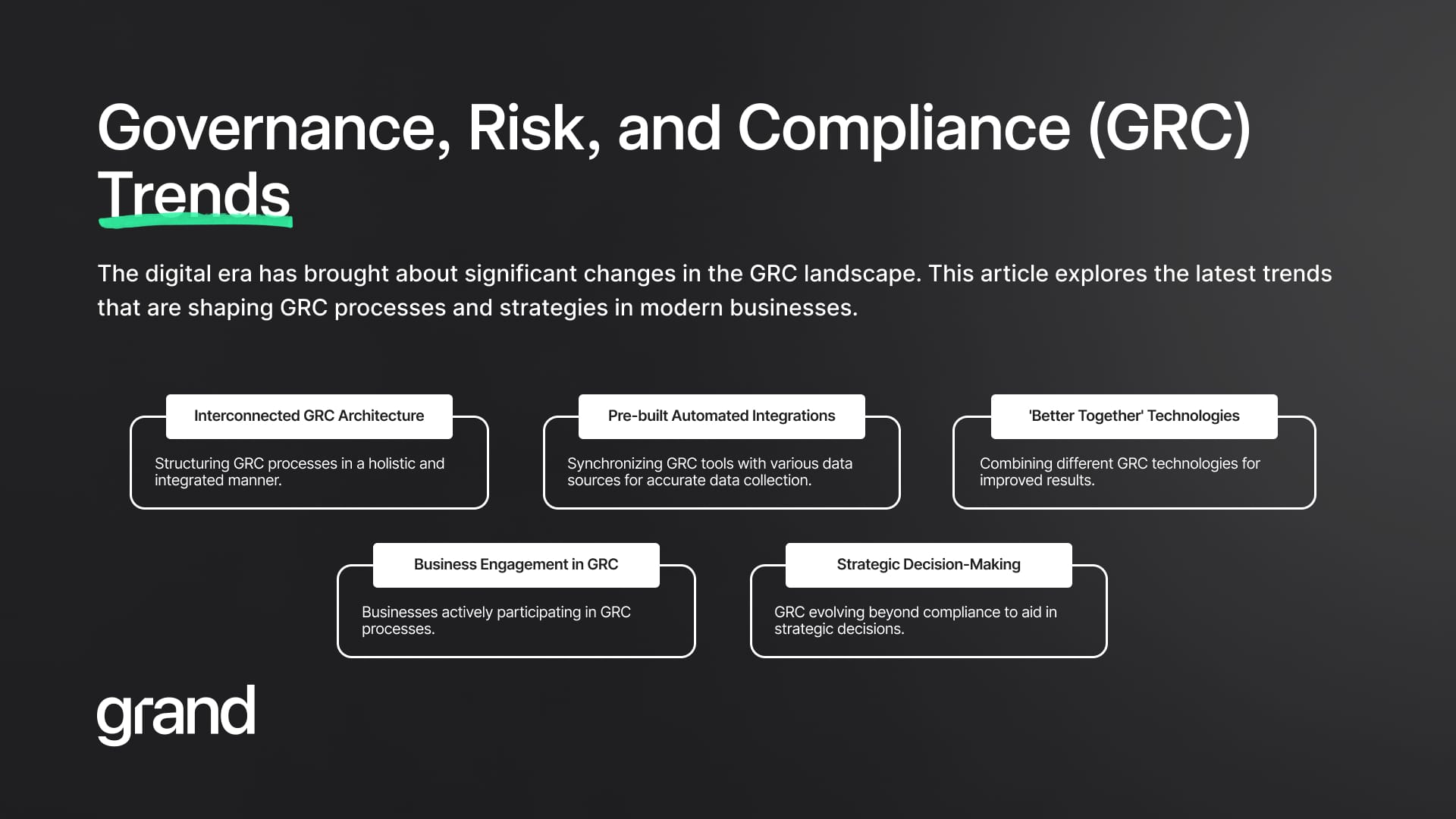Which are the governance risk and compliance (GRC) trends?
In a collaborative dialogue about the digital era's Governance, Risk, and Compliance (GRC) landscape, we uncovered its profound evolution and relevance for modern businesses.

Governance, Risk, and Compliance (GRC) Trends: Technologies, EU Regulations, and the Role of ISSB Standards
Governance, Risk, and Compliance (GRC) functions are experiencing a transformational shift in 2025. Financial institutions and compliance teams face an unprecedented tempo of change: industry surveys show that over 40 percent of organisations encountered at least three critical risk events within the past year, while 73 percent devote substantial time each week to tracking new regulatory requirements. In parallel, the European Union’s expanding rule-set, from digital operational resilience to sustainable-finance mandates, has raised compliance costs and complexity. GRC leaders must now navigate an interlocking web of threats: sophisticated cyber-attacks, geopolitical volatility, Environmental, Social, and Governance (ESG) pressures, and alignment with International Sustainability Standards Board (ISSB) Standards.
The market’s answer is a decisive pivot toward agile, fully integrated GRC frameworks that enable faster adaptation and holistic, proactive risk stewardship. This article delivers an expert, experience-based analysis of the foremost GRC trends for 2025, with a special focus on the financial sector. We unpack the EU’s most consequential regulatory initiatives, examine emerging technologies, artificial intelligence (AI), machine learning (ML), blockchain, advanced ESG analytics, and spotlight next-generation GRC software capabilities such as unified platforms, automated controls, quantitative risk analysis, and end-to-end third-party risk governance.
Source
[1]

[3]

Regulatory Developments Shaping Governance, Risk, and Compliance (GRC): EU Perspective
The European Union (EU) remains the most active jurisdiction for Governance, Risk, and Compliance (GRC) legislation in 2025. A steady flow of new and revised rules, covering operational resilience, data governance, market integrity, and sustainability, now defines the baseline for banks, insurers, asset managers, and listed companies. With enforcement timelines converging, compliance functions must be both robust and agile to absorb regulatory change while upholding the International Sustainability Standards Board (ISSB) Standards and broader GRC trends.
1. Operational Resilience & ICT Risk: Digital Operational Resilience Act (DORA)
- Scope: Creates a single EU rule-set for Information and Communication Technology (ICT) risk, covering banks, insurers, investment firms, and critical third-party IT providers.
- Key obligations: Enterprise-wide ICT risk frameworks, incident reporting, penetration testing, and contractual oversight of service providers.
- Timeline: In force since January 2023; fully applies from 17 January 2025.
- Strategic impact: GRC teams are aligning cyber-risk metrics, business-continuity plans, and vendor-risk controls to DORA’s prescriptive standards. Similar resilience expectations from the Basel Committee, UK PRA, and US regulators reinforce a global shift toward resilience-first compliance.
2. Data Protection & Privacy: General Data Protection Regulation (GDPR)
- Scope: Sets stringent EU-wide rules for personal-data processing, breach notification, and data-subject rights.
- Timeline: Adopted April 2016; effective since 25 May 2018.
- Strategic impact: GDPR remains the gold standard that shapes privacy laws worldwide. Financial institutions have embedded Data Protection Officers, breach-response drills, and continuous privacy-risk assessments into their GRC architecture.
3. Market Integrity & Investor Protection: Markets in Financial Instruments Directive II (MiFID II)
- Scope: Enhances transparency, best-execution duties, product governance, and trade reporting for securities markets.
- Timeline: Effective across the EU on 3 January 2018; iterative updates continue, and consultation on a potential “MiFID III” is under way.
- Strategic impact: Conduct-risk surveillance systems, granular record-keeping, and staff training remain critical. Coverage now extends to emerging asset classes, crypto-assets and fintech platforms, requiring integrated, cross-product compliance monitoring.
4. Sustainability & ESG Reporting: Corporate Sustainability Reporting Directive (CSRD)
- Scope: Expands mandatory ESG disclosures to roughly 50,000 EU companies, referencing European Sustainability Reporting Standards (ESRS) and aligning with ISSB requirements.
- Timeline: Adopted 2022; applies to FY 2024 statements published in 2025.
- Strategic impact: GRC functions must capture, verify, and assure ESG metrics, carbon emissions, climate risk, workforce diversity, human-rights due diligence, and embed them within risk-management and board-governance processes. Globally, regulators are adding climate-stress tests and investor-driven sustainability audits, making ESG a core GRC pillar.
Quick Reference: Key EU Regulations Driving GRC in 2025
| Regulation | Primary Focus | Applies From |
|---|---|---|
| DORA | ICT resilience, third-party service oversight | 17 Jan 2025 |
| GDPR | Data protection & privacy | 25 May 2018 |
| MiFID II | Market transparency, investor protection | 3 Jan 2018 (ongoing updates) |
| CSRD | Mandatory ESG reporting (aligned with ISSB/ESRS) | FY 2024 reports (due 2025) |
5. The Moving Target of Compliance
Beyond the flagship rules above, firms must track Anti-Money Laundering directives, the Digital Markets Act, the forthcoming EU AI Act, and sector-specific guidance. A recent industry survey finds “keeping pace with regulatory change” and “managing compliance costs” remain the top two challenges for Chief Compliance Officers. Leading institutions are therefore:
- Deploying regulatory-intelligence platforms that map global rule changes to internal controls in real time.
- Automating continuous-control monitoring to detect gaps before regulators do.
- Expanding training and culture programmes to promote ethics and accountability, moving beyond checkbox compliance.
Takeaway for 2025 GRC Leaders
The EU’s 2025 rule-book demands holistic, tech-enabled, and sustainability-aware compliance frameworks. Embedding DORA resilience tests, GDPR privacy controls, MiFID II conduct surveillance, and CSRD-aligned ESG data—while referencing ISSB Standards for global comparability, positions organisations to meet regulators’ expectations and build stakeholder trust in the evolving landscape of Governance, Risk, and Compliance.

Technologies Transforming Governance, Risk, and Compliance (GRC) in 2025
Innovation is reshaping GRC from a retrospective, checklist-driven function into a real-time, predictive, and integrated discipline. Five technology domains, AI/ML, blockchain, advanced analytics, ESG intelligence, and cloud automation, now anchor best-in-class programmes and align directly with International Sustainability Standards Board (ISSB) Standards and broader GRC trends.
1. Artificial Intelligence & Machine Learning
- Continuous monitoring: AI engines scan internal data streams and external threat feeds around the clock, surfacing anomalies long before periodic reviews would catch them.
- Predictive analytics: Machine-learning models forecast cyber-incidents, fraud patterns, and emerging compliance hotspots, enabling proactive mitigation. Gartner projects a 25 % reduction in cybersecurity incidents by 2026 for firms deploying AI-based controls.
- Reg-tech automation: Natural Language Processing ingests regulatory texts and maps each requirement to existing policies, cutting manual workload by roughly 50 % while boosting accuracy.
- Audit optimisation: Algorithms collect evidence, test controls, and draft audit work-papers autonomously, freeing specialists to focus on judgement calls.
- Governance considerations: Robust model-risk management, bias testing, and transparent AI decision logs are mandatory to preserve trust in automated GRC.
2. Blockchain & Distributed Ledger Technology: Immutable Compliance Records
- Tamper-proof audit trails: Immutable ledgers record trades, approvals, and Know-Your-Customer (KYC) artefacts, guaranteeing data integrity for regulators and auditors.
- Shared KYC utilities: Consortium blockchains promise a single, continuously updated source of customer identity data, slashing duplication across institutions and accelerating Anti-Money-Laundering (AML) checks.
- Supply-chain transparency: Tokenised tracking of raw materials evidences responsible sourcing, supporting ESG and sanctions-screening controls.
- Smart-contract compliance: Self-executing code can block prohibited transactions or trigger mandatory filings once risk thresholds are breached.
- Adoption hurdles: Legacy-system integration, privacy on public chains, and cross-industry standards require careful roadmap planning.
3. Data Analytics & Quantitative Risk: From Qualitative Scores to Financial Impact
- Risk quantification: Monte Carlo simulations and scenario analyses assign monetary values to operational and compliance risks, helping executives allocate capital where it matters most.
- Loss-event benchmarking: Major banks reported €17.8 billion in operational-risk losses in 2022; benchmarking such data strengthens the case for enhanced controls.
- Decision support: Interactive dashboards transform raw metrics into board-level insights, aligning risk appetite with strategic objectives.
4. ESG & ISSB-Aligned Intelligence: Sustainability as a Core GRC Pillar
- Comprehensive data capture: Automated pipelines gather carbon emissions, energy usage, workforce diversity, and human-rights indicators across the value chain.
- Scenario modelling: Climate-risk analytics test the financial impact of floods, droughts, or carbon pricing on assets and operations, critical for strategy and capital planning.
- Regulatory alignment: Tools map enterprise data directly to European Sustainability Reporting Standards (ESRS) and ISSB Standards, ensuring disclosure readiness under the Corporate Sustainability Reporting Directive (CSRD).
- Stakeholder trust: Data-driven ESG governance enhances credibility with investors, regulators, and customers alike.
5. Cloud Platforms, Low-Code, and Robotic Process Automation: Unified, Agile Compliance
- Single source of truth: Cloud-native GRC suites integrate risk assessments, control libraries, incident logs, and audit findings on scalable infrastructure.
- Workflow automation: Robotic Process Automation (RPA) bots compile evidence, validate control performance, and submit filings, reducing manual effort and speeding cycle times.
- Low-code agility: Drag-and-drop configuration lets compliance teams update workflows or dashboards without heavy IT intervention, vital when regulations shift weekly.
- Scalability & cost-efficiency: Elastic resources match enterprise growth and regulatory complexity, maintaining performance without excessive overhead.
GRC Software & Solution Trends 2025: Unified, Proactive, and Quantified
Modern Governance, Risk, and Compliance (GRC) programmes are abandoning siloed, checklist-driven practices in favour of integrated, forward-looking platforms that embed International Sustainability Standards Board (ISSB) Standards alongside conventional risk and regulatory requirements. Two dominant themes, unification and proactivity, define best-in-class GRC technology for 2025.
1. Unified GRC Platforms & Integrated Risk Management
Why it matters
- Historically, operational risk, IT risk, compliance, audit, and ESG teams operated on isolated spreadsheets and niche tools.
- Siloes obscure cross-domain interdependencies, e.g., a supplier outage that triggers data-privacy violations and financial losses simultaneously.
Key capabilities
| Capability | Business Benefit |
|---|---|
| Single data model for risks, controls, and objectives | Enterprise-wide “single source of truth” that accelerates reporting and decision-making |
| Real-time dashboards for executives | Instant visibility into risk indicators, compliance status, and ISSB-aligned ESG metrics |
| Cross-functional workflows | Coordinated response when regulations change or incidents occur |
Impact & adoption
- Only 20 % of organisations have fully integrated risk, compliance, and resilience functions today—leaving substantial room for improvement.
- Firms that complete the integration report:
- Fewer control gaps or overlaps
- Faster reaction to emerging threats
- Stronger, enterprise-wide risk culture
2. Automated & Proactive Compliance Management
From reactive to real-time
- Regulatory updates multiply weekly; 73 % of compliance teams still spend hours manually tracking rule changes.
- Proactive programmes deploy regulatory-intelligence feeds that map new laws to internal controls the moment they appear.
Continuous control monitoring
- Automated tests run 24/7 on access rights, transaction limits, configuration settings, and more.
- Issues surface immediately—e.g., dormant user accounts flagged after 30 days instead of at the next quarterly audit.
End-to-end compliance workflow
- Regulatory horizon scanning: AI parsers classify and tag new requirements.
- Mapping & impact analysis: Platform pinpoints affected policies, procedures, and ISSB-linked disclosures.
- Control update & evidence capture: Low-code tools push revisions; RPA bots gather proof of control effectiveness.
- Board-level reporting: Real-time dashboards and heat maps highlight residual risk and remediation progress.
Strategic upside
- Regulators increasingly demand proof of “always-on” compliance; automated logs and remediation records satisfy that expectation.
- Embedding compliance KPIs into executive scorecards elevates the function from back-office cost centre to strategic advantage.
Quantitative Risk Analysis & Risk Quantification Tools: Elevating Decision-Making in GRC Trends 2025
Modern Governance, Risk, and Compliance (GRC) programmes now extend rigorous, loss-based quantification beyond credit and market risk to the traditionally “softer” domains of operational, compliance, and strategic exposure. Executives and regulators alike demand numeric clarity, grounded in International Sustainability Standards Board (ISSB) Standards and enterprise-risk guidelines—to compare diverse threats on an objective scale.
Key elements of next-generation risk quantification
| Element | Purpose | 2025 Best Practice |
|---|---|---|
| Data-driven modelling | Convert historical incidents into probability curves | Monte Carlo engines simulate thousands of loss scenarios for fraud, cyber, or ESG breaches |
| Scenario analysis | Test low-frequency, high-impact events | Model a large-scale data breach or critical supplier failure and express impact as € potential loss |
| Risk-appetite metrics | Link quantitative thresholds to strategy | Example: “Operational losses ≤ 0.5 % of annual revenue” or “cloud downtime ≤ 0.1 %” |
| Board-ready insight | Make risk tangible for funding decisions | “A major cyber incident could cost €50 million—mitigating controls reduce expected loss by 60 %” |
Quantification sharpens capital allocation, supports regulatory filings (e.g., Basel operational-risk capital), and aligns risk priorities with sustainability goals defined by ISSB. Organisations leveraging AI-assisted statistical tools, Bayesian networks, and real-time business-intelligence feeds gain a decisive advantage in steering resources where they cut true exposure, not just perceived threat.
Third-Party Risk Management & Supply-Chain Resilience
With 98 % of organisations connected to at least one breached vendor in the past two years, third-party ecosystems are a leading risk vector. Upcoming rules such as DORA tighten oversight, compelling firms to treat vendor failures as internal risks and to integrate TPRM into unified GRC platforms.
End-to-end TPRM framework
- Mapping & inventory — Maintain a live register covering vendors, subcontractors (fourth parties), services provided, and data flows.
- Due diligence & onboarding — Score cybersecurity, financial stability, ESG alignment, and compliance certifications.
- Contractual safeguards — Embed right-to-audit, data-protection, and exit-strategy clauses referencing ISSB and sector-specific standards.
- Continuous monitoring — Automate questionnaires, external cyber-ratings, dark-web scans, and news scraping for each critical supplier.
- Incident response & resilience — Prepare playbooks, backup providers, and coordinated communications that activate when a vendor disruption occurs.
By viewing third-party risk through a single, integrated GRC lens, organisations identify cascading effects—such as a cloud outage triggering GDPR fines and service-level penalties—well before damage escalates. Collaboration among procurement, IT security, compliance, and continuity teams, supported by automation and analytics, transforms TPRM from a periodic checkbox into a continuous shield.
Agility & Trust at the Core of GRC Trends 2025
The 2025 risk landscape challenges financial institutions with cyber threats, geopolitical shocks, climate pressures, and relentless regulatory updates. Yet the same era offers powerful enablers: AI-driven analytics, unified GRC platforms, risk quantification engines, and resilient third-party ecosystems, each aligned with ISSB Standards and the broader GRC Trends imperative.
Success demands a forward-looking, proactive mindset:
- Integrate data, controls, and reporting across siloes to create a single source of truth.
- Automate compliance and monitoring for real-time assurance instead of quarterly surprises.
- Quantify risk so the board can weigh mitigation costs against concrete financial exposure.
- Embed ethical governance and sustainability into every decision, earning stakeholder confidence through demonstrable Experience, Expertise, Authoritativeness, and Trustworthiness.
Organisations that treat GRC as a strategic catalyst, rather than a cost centre, will safeguard reputation, secure competitive advantage, and fuel sustainable growth in the financial sector’s next chapter.
Reduce your
compliance risks


.png)
